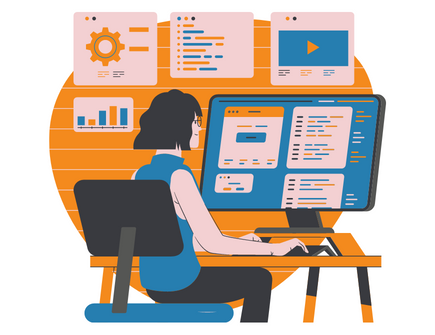 Digital transformation is affecting every industry in some way or another. The way we bank, the way we purchase goods and services, the way we interact with healthcare providers – it’s all changing because of the digital transformation journeys undertaken by businesses across the globe. In this blog post, we’ll explore how different industries are being transformed by digital technologies, and discuss the implications for businesses and consumers alike.
Digital transformation is affecting every industry in some way or another. The way we bank, the way we purchase goods and services, the way we interact with healthcare providers – it’s all changing because of the digital transformation journeys undertaken by businesses across the globe. In this blog post, we’ll explore how different industries are being transformed by digital technologies, and discuss the implications for businesses and consumers alike.
Summary of Industries Currently Affected by Digital Transformation
- Banking
- Healthcare
- Travel
- Energy
- Automotive
- Food
- Manufacturing
- Warehousing and Distribution
- Insurance
- Retail

Digital Transformation in the Banking Industry
The banking sector is under pressure as consumers shift their spending to tap into new technological frontiers. This is particularly apparent in the payments space, where both retail and institutional investors are benefiting from the race to adopt new technologies, such as mobile payments and cloud-based banking. Banks are also feeling the pinch when it comes to interest rates and interchange fees. In order to remain competitive, they need to find ways to cut costs and improve efficiency. One way they are doing this is by implementing digital transformations, allowing them to stay ahead of the curve and evolve in line with improved technologies.
Examples of Digital Transformation in Banking
Some core examples of digital transformation in practice in the banking industry include automated fraud detection and prevention software, the adoption of cloud computing to cut reliance on internal data centres, the analysis of Big Data to improve customer experience, and the proliferation of new payment methods (think Square Readers).
Benefits of Digital Transformation in Banking
Digital transformation has generally aided financial institutions by helping them to automate processes, reduce fraud risks, and speed up product approvals. A lot of these changes have also allowed banks to tap into new revenue streams, with improved data analytics and artificial intelligence driving improved risk management and providing informed forecasts. The strides made in data analysis have also allowed banks to better reach prospective customers through customer journey mapping and more targeted advertising.
Additionally, digital transformation can help banks improve customer experience by offering more personalised services and products. There have also been marked improvements to security, with customer data now more protected than ever.
Challenges of Digital Transformation in Banking
Given the scale of most banking operations and the high sensitivity associated with customer financial data, digital transformation strategies in the banking sector are often extremely costly to implement. These costs are typically incurred when purchasing the hardware and software required to facilitate proper digital transformation, as well as the time required to train personnel to put them to use. It’s not enough to simply purchase advanced technology and immediately roll it out to your customers, an effective banking digital transformation strategy often requires months of careful planning and testing. Ensuring that evolutions are properly implemented is a challenge that is often much harder than it seems on paper.

How Digital Transformation is Changing the Healthcare Industry
The healthcare industry is currently undergoing a digital transformation. This means that healthcare organisations are using digital technologies to improve patient care, communication, and outcomes. One of the most important ways that digital transformation is changing healthcare is by improving patient engagement. Through the use of digital tools, patients are now able to be more involved in their own care. They can track their health data, communicate with their care team, and access educational resources. This increased engagement leads to better health outcomes for patients and improved satisfaction with the healthcare system. In addition, digital transformation is also helping to improve communication between care providers. By using digital platforms, providers can share information more easily and quickly respond to changes in a patient’s condition. This improved communication can help to prevent errors and improve overall patient care. Ultimately, digital transformation is leading to a more efficient and effective healthcare system that is better able to meet the needs of patients.
Examples of Digital Transformation in Healthcare
Potent examples of digital transformation in the healthcare industry include the use of AI to identify potential abnormalities in patients, the automation of mundane tasks (such as paperwork) to reduce fatigue, remote consultations with health professionals, and the analysis of Big Data to track disease.
Benefits of Digital Transformation in Healthcare
As previously mentioned, many of the notable digital transformations in the healthcare industry serve to facilities a more connected, efficient, and effective healthcare system. Wearable technologies allow healthcare providers to better track the conditions of their patients, allowing them to provide better care and prevent potential medical episodes. Additionally, improved digital communications technologies have allowed for smoother and more transparent information sharing between practitioners.
Challenges of Digital Transformation in Healthcare
Like many other industries, a lot of the challenges associated with digital transformation in the healthcare industry can be linked to the management and security of sensitive patient data. The importance of privacy in the healthcare industry cannot be understated, making proper cybersecurity and data privacy processes particularly challenging to implement. Additionally, whilst telehealth appointments are undoubtedly useful for a wide range of patients and practitioners, proper assessment and diagnosis is often hard to achieve in a remote setting.

Digital Transformation in the Travel Industry
In recent years, there has been a surge in digital transformation across industries, with travel is no exception. From online booking platforms to paperless boarding passes, digital technology is reshaping the way we travel. One of the most significant changes has been the rise of mobile apps. Today, there are apps for almost everything, from finding the best route to your destination to ordering an Uber to take you to the airport. Combine this with the advent of mobile payment systems, such as Apple Pay and Google Pay, and it’s now possible to book a hotel room or rental car and pay for it all without ever taking out your wallet. Another consequence of digital transformation is increased competition. With so many options available at our fingertips, travellers are no longer loyal to any one brand. Instead, they’re constantly searching for the best deals and the most convenient way to book their trip. As a result, airlines and hotel chains are under constant pressure to offer competitive prices and user-friendly booking experiences. There can be no doubt that digital transformation is radically changing the travel industry.
Examples of Digital Transformation in Travel
There are countless examples of digital transformation in play throughout the travel industry, with personalised ads being sent to potential travellers, AI chatbots to help with bookings, digital boarding passes, and VR hotel tours serving as a small sampling. Travel companies are really starting to embrace digital innovation now that the world is open again and people are resuming their travels. These companies are using data collected on their target audiences to develop strategies and map customer behaviour, providing them with a competitive advantage in the market and allowing them to better identify opportunities. Smartphones sit at the core of most digital transformations seen in the travel industry, now possessing the ability to book entire trips, guide traveller movements, communicate in foreign languages, and influence future destinations. Platforms such as Instagram and TikTok now serve as highly effective marketing tools for the travel industry, providing audiences with short and typically romanticised content encouraging them to visit a variety of destinations.
Benefits of Digital Transformation in Travel
Emerging technologies in the travel space are serving to benefit both travel providers and travellers themselves. As previously mentioned, smartphones now allow travellers to book their trips, effective communicate in other languages, and guide themselves around foreign lands. Numerous apps and online services now exist with the express purpose of highlighting must-see landmarks and events across the globe, providing travellers with an unlimited number of things to see and do. The travel industry has also benefitted heavily from these transformations, with automation and data analysis working to speed up processes, reduce costs, and provide actionable insights.
Challenges of Digital Transformation in Travel
The rapid proliferation of digital technologies in the travel industry has resulted in an packed market, making it challenging for travellers to differentiate between businesses and brands operating in the space. This crowded market has created somewhat of a ‘race-to-the-bottom’ between travel businesses, as travellers often lack brand loyalty and instead look for the cheapest or most convenient option. Some of the most effective marketing content centres around the allure of a location, raising awareness and interest in a specific market but not necessarily a specific business. Like most other industries, cybersecurity is another core challenge facing the digital travel industry, particularly when travellers are operating from unsecured internet connections in unfamiliar locations.

Digital Transformation in the Energy Industry
The energy industry is in the midst of a digital transformation. The traditional model of energy production and delivery is being disrupted by new technologies and business models. This is changing the way that utilities, grid operators, and consumers interact with the energy system.
One of the most significant changes is the way that consumers are using energy. The proliferation of distributed energy resources, such as solar PV and storage, is giving consumers more control over their energy consumption. This is putting pressure on utilities to adapt their business models to meet the needs of these empowered consumers.
The rise of electric vehicles is another transformative trend. Electric vehicles are expected to play a major role in decarbonising transportation, one of the largest sources of greenhouse gas emissions. The growth of electric vehicles will also have implications for the electricity grid, as charging them will place demands on the system that are different from those of traditional combustion engine vehicles.
Digital technologies are also enabling new business models in the energy industry. For example, companies are developing “virtual power plants” that use battery storage and solar PV to provide grid services, such as peak demand response, while also generating revenue for the company. These types of business models were not possible before the advent of digital technologies.
The energy industry is undergoing a major transformation, driven by digital technologies. This is changing the way that utilities, grid operators, and consumers interact with the energy system. It is also opening up new opportunities for companies that are able to capitalise on this change.
Examples of Digital Transformation in the Energy Industry
Some examples of digital transformation in the energy industry include the rise of AI to optimise energy usage, automation of billing and measurement, IoT (internet of things) connected devices to analyse processes, and the proliferation of real-time data regarding outages and their causes.
Benefits of Digital Transformation in the Energy Industry
The core benefit of digital transformation in the energy industry relates directly to the way in which new technologies are improving efficiency, bolstering workplace safety, and leading the way towards renewable sources of energy. The enormous amount of information being analysed by data scientists across the energy industry is leading the way for cleaner energy solutions, allowing businesses to optimise usage and improve core systems. Improvements made to data analysis and operational efficiency are also poised to improve the lifespan of infrastructure across the energy industry, facilitating better upkeep and ensuring better return on investment. Digital transformation is also benefitting communications between customers and providers, with artificial intelligence chatbots helping to service easily explainable concerns whilst human interactions are saved for more complex matters.
Challenges of Digital Transformation in the Energy Industry
Whilst the energy industry shares a lot of the same digital transformation challenges previously mentioned, namely data security and effective implementation, they also possess a number of unique hurdles. Firstly, the frankly unfathomable scale of most businesses in the energy industry ensures that investment in digital transformation must require significant funding and commitment to get off the ground. The high number of moving pieces and reliance on outsourced or offshore work means that a lot of these digital transformations need to be applicable across the board, otherwise risking potential disconnect and limiting business outcomes. Additionally, all changes, digital or otherwise, need to comply to the strict set of health and safety standards often laid out by energy companies. These standards can often slow the implementation of new technologies and limit their potential benefits.

Impact of Digital Transformation on the Automotive Industry
Digital transformation is seen almost everywhere you look in the automotive industry. The rise of electric vehicles, ride-sharing services, and autonomous vehicles is upending traditional business models and forcing automakers to rethink their approach to design, manufacturing, and marketing. As a result, the automotive market is rapidly changing, and the competitive landscape is becoming more complex. While some legacy automakers are struggling to adapt, new players are emerging as leaders in the new automotive ecosystem. To survive and thrive in this rapidly changing environment, automakers must embrace digital technologies and adopt a customer-centric approach. This shift will require a fundamental change in mind-set and culture, but those that are able to make the transition will be well positioned to dominate the automotive landscape of the future.
Examples of Digital Transformation in the Automotive Industry
Design and Development: Automotive designers and engineers are using virtual reality (VR) and augmented reality (AR) to create immersive experiences that allow them to explore different design options and make better decisions. They are also using 3D printing to create prototypes and test new designs.
Manufacturing: Automakers are using digital technologies to streamline manufacturing operations and reduce costs. For example, they are using robotics and 3D printing to create custom parts on demand, rather than having to produce large quantities of parts in advance. They are also using data analytics to optimise production line efficiency.
Business Models: New business models are emerging as a result of the automotive industry’s digital transformation. For example, subscription-based models (such as Care by Volvo) offer customers an all-in-one solution that includes the car, maintenance, insurance, and roadside assistance. Car sharing models like Zipcar provide customers with access to a wide range of reservable vehicles that can be booked out for minutes, hours, or even days.
Customer Experience: Digital technologies are transforming the way customers interact with car companies and purchase vehicles. Online configurators allow customers to build their perfect car from the comfort of their own home. Online car buying platforms, such as the one used by Tesla, allow customers to purchase cars without ever stepping foot into a dealership.
Benefits of Digital Transformation in the Automotive Industry
The automotive industry has undergone a significant digital transformation in recent years, adopting new technologies to improve manufacturing efficiency and vehicle quality. One of the most significant benefits of this transformation is the ability to share data across the entire supply chain. By digitising production data, automotive companies can obtain real-time insights into supplier performance, identify potential quality issues early on, and make more informed decisions about inventory levels. In addition, digital transformation has resulted in shorter lead times from design to production, as well as reduced costs and improved margins. As the automotive industry continues to digitise, these benefits are only likely to increase
Challenges of Digital Transformation in the Automotive Industry
The challenges of digital transformation are numerous, but perhaps the most significant is the need to completely rethink the design and production process. For instance, traditional carmakers have relied on incremental improvements to internal combustion engine technology for generations. However, the rise of electric vehicles requires a completely different approach, and many companies are struggling to make the transition. In addition, the increasing complexities of software and hardware development are posing challenges for suppliers and manufacturers alike. The good news is that there are plenty of opportunities for companies that are willing to embrace digital transformation. Those that do will be well-positioned to meet the needs of tomorrow’s consumers.

Digital Transformation in the Food and Beverage Industry
The way we grow, harvest, and consume food has changed dramatically over the last century. Advances in technology have led to larger and more efficient farms, as well as new methods of food processing and preservation. However, the pace of change is accelerating, and the food industry is now undergoing a digital transformation. This is leading to a more efficient and sustainable food system, with far-reaching implications for both consumers and producers.
Examples of Digital Transformation in Food and Beverage
A core example of food and beverage digital transformation is the use of sensors and data analytics is allowing farmers to optimise irrigation and crop yield. These types of sensors are also used to ensure that foods are kept in optimal conditions before finding their way to your local supermarket. Blockchain technology is also being used to track food items from farm to table, making it easier to identify and recall contaminated products. In addition, mobile apps are giving consumers unprecedented choice and transparency when it comes to what they eat. Mainstays such as Uber Eats and DoorDash are connecting businesses with consumers closer than ever before, providing new revenue streams and lowering barriers to access. As these and other technologies are adopted, the food industry will continue to evolve in exciting and unexpected ways.
Benefits of Digital Transformation in Food and Beverage
Digital transformations provide a number of benefits across the food and beverage industry. Advanced analytics have allowed food and beverage companies to better optimise their offerings, ensuring that they’re working efficiently and productively without compromising quality. As previously mentioned, smart sensors and other technologies have facilitated improved food safety, allowing business to better stay in line with regulations and ultimately resulting in better products for consumers. Improvements made to digital communications processes also have the benefit of allowing businesses to better track their supply chains and passing relevant information on to the consumer. Some businesses are even going as far as including QR codes or links on their products that allow purchasers to see where individual ingredients were sourced from.
Challenges of Digital Transformation in Food and Beverage
In line with the other industries discussed above, digital transformation in the food and beverage industry can be a complex and costly process. In order to successfully navigate the challenges of digital transformation, food and beverage companies need to have a clear strategy and roadmap in place. They also need to invest in the right technology and partner with an experienced digital solutions consultant or consultants. This can be extremely difficult to achieve from the outset, often requiring a period of trial and error to determine which technologies serve as the ideal fit. With careful planning and execution, digital transformation can help the food and beverage industry unlock new growth opportunities, improve customer engagement, and gain a competitive edge of their competition.

Digital Transformation in Manufacturing
In recent years, there has been a major shift in the manufacturing industry towards digital transformation. This term refers to the use of digital technologies to improve various aspects of the manufacturing process, from product development and design to production and distribution. By integrating digital technologies into all aspects of operations, manufacturers can improve efficiency, optimise production, and create a more agile and responsive organisation.
Examples of Digital Transformation in Manufacturing
Some examples of digital transformation in manufacturing include the use of 3D printers to create prototypes and customised products, data analytics to improve quality control, and the use of robotics and automation to eliminate human error and speed up production.
Benefits of Digital Transformation in Manufacturing
By digitising production processes and using data-driven methods, manufacturers can achieve a number of important benefits. Perhaps most importantly, digital transformation can lead to increased efficiency and productivity. In particular, it can help to reduce wastefulness throughout the manufacturing process, and it can enable manufacturers to respond more quickly to changes in customer demand. Additionally, digital transformation can help improve product quality by providing better visibility into the manufacturing process. Finally, digital transformation can also help manufacturers to become more agile and adaptive, allowing them to rapidly respond to changes in the marketplace. As the benefits of digital transformation become increasingly clear, it is likely that more and more manufacturers will begin to adopt these technologies in the years to come.
Challenges of Digital Transformation in Manufacturing
One of the biggest challenges is data overload. With so much data being generated by factories, it can be difficult to sift through everything and identify the insights that will really make a difference. Another challenge is developing the right technology infrastructure. In order to take full advantage of digital tools, factories need to have a robust network and computing infrastructure in place. Finally, there is the issue of change management. Implementing digital transformation can be disruptive to operations, and companies need to carefully manage the process to ensure minimal disruptions.
Despite these challenges, digital transformation is essential for manufacturing companies that want to remain competitive in the future. By addressing these challenges head-on, companies can position themselves for success in the digital age.

Digital Transformation in Distribution and Warehousing
In recent years, there has been a growing trend towards digital transformation in the distribution and warehousing industry. This has been driven by a number of factors, including the need for greater efficiency and agility, the rise of e-commerce, and the increasing availability of data and analytics. As a result, many warehouses and distribution centres are investing in new technologies, such as robotics and automation, to improve their operations. In addition, they are also adopting new methods of data management and analysis to gain insights into their business. These changes are having a significant impact on the way that warehouses and distribution centres operate, and they are likely to continue to do so in the future.
Examples of Digital Transformation in Distribution and Warehousing
In recent years, we’ve seen a number of businesses in the distribution and warehousing industry embrace digital transformation in order to improve efficiency and competitiveness. Here are just a few examples:
Several leading companies have invested in wearable technology for their workers. This has helped to increase productivity by allowing employees to have real-time access to information and data. In addition, it’s also led to improved safety levels as employees can now be more aware of their surroundings.
Another area where digital transformation has made an impact is in the way inventory is managed. Many businesses are now using sensors and other tracking devices to manage stock levels more effectively. This has resulted in reduced losses due to theft or errors, and also allowed businesses to respond more quickly to customer demand.
Lastly, we’ve also seen a trend towards automated warehouses. By investing in robotics and other automated systems, businesses have been able to reduce labour costs while still maintaining high levels of accuracy and productivity. This has allowed them to stay ahead of the competition and become more agile in the marketplace.
Benefits of Digital Transformation in Distribution and Warehousing
Outside of the clear benefits outlined in the examples above, digital transformation is helping distribution and warehousing by improving inventory tracking, packing processes, and optimising route planning for incoming and outgoing goods. For example, the use of RFID tags can help to keep track of inventory levels in real time, while data analytics can be used to optimise route planning and track the performance of individual items. In addition, the use of robotics and automation can help to speed up the picking and packing process. As a result, businesses that embrace digital transformation in their distribution and warehousing operations can enjoy a significant competitive advantage.
Challenges of Digital Transformation in Distribution and Warehousing
Numerous challenges exist within the distribution and warehousing industry. Firstly, the sheer volume of data generated by these types of operations can be overwhelming, making it particularly difficult to glean meaningful insights from it all. Additionally, the transition to digital can be disruptive to longstanding processes and procedures, potentially leading to disruptions in the supply chain. Finally, there is the challenge of integrating new technologies into existing systems in a way that is both efficient and effective.
While there are many challenges associated with digital transformation, there are also many opportunities. By embracing digital technologies, businesses can improve their visibility into their operations, optimise their use of resources, and ultimately improve their bottom line.

How Digital Transformation is Changing the Insurance Industry
In the past, insurance companies have relied on paper-based systems and manual processes to manage risk and administer claims. However, the advent of new digital technologies is enabling insurers to move away from these traditional methods and towards a more data-driven approach. By collecting and analysing data from a variety of sources, insurers are able to gain a more comprehensive understanding of risk. This in turn allows them to develop more effective risk management strategies and pricing models. In addition, digital technology is also helping to improve the claims process, making it faster and more efficient. In a very similar way to the banking industry, digital transformation is having a profound impact on the insurance providers, making them more agile and responsive to the needs of customers.
Examples of Digital Transformation in Insurance
The insurance sector has been slower than most when it comes to digital transformation, but that is starting to change. One example is the way in which insurers are using data and analytics to better understand their customers. This data can be used to develop more personalised products and services, as well as to assess risk more accurately. Major insurance companies across the globe now employ data science experts to dig deep into relevant information and chart a path forward for their business. Insurers are also using technology to automate manual processes, such as claims handling and underwriting. This not only saves time and money, but it also helps to improve customer satisfaction. In addition, insurers are using digital channels such as mobile apps and chatbots to provide a better customer experience. These are just a few examples of how insurers are using digital technologies to transform their businesses.
Benefits of Digital Transformation in Insurance
Some of the most significant benefits of this digital transformation include increased efficiency, lower costs, and better customer engagement. Digital transformation is also benefiting insurers in other ways. For example, it is helping them to identify fraud more effectively and reducing the likelihood of errors. In addition, digital processes make it easier to comply with regulations and share data with regulators. Ultimately, digital transformation is enabling insurers to better meet the needs of their customers while also improving their own bottom line.
Insurance Digital Transformation Challenges
Despite the clear benefits of digital transformation for insurance companies, this process has not been without its challenges. One of the biggest challenges is data management. As insurers strive to become more data-driven, they are collecting large amounts of data from a variety of sources. This data must be accurately stored, organised, and accessed in order to make informed decisions. Another challenge is integrating new technology into existing systems. Many insurers are still using legacy systems that are not compatible with new technology. This can make it difficult to take advantage of the latest tools and innovations. Finally, another challenge is attracting and retaining talent. The insurance industry is facing stiff competition for top tech talent. In order to attract and retain the best workers, insurers need to offer competitive salaries and benefits packages. Despite these challenges, the insurance industry is making great strides in its digital transformation. By overcoming these challenges, insurers will be well-positioned to thrive in the digital age.

Retail Digital Transformation
In recent years, there has been a dramatic shift in the retail landscape. Thanks to the rise of digital technologies, consumers are now more connected and empowered than ever before. They can shop online at any time of day or night, compare prices and products with the click of a button, and have purchases delivered to their doorstep within days. This continued growth of e-commerce has been a major disruptor for traditional brick-and-mortar retailers, who have been forced to re-think their business models in order to stay competitive. Many retailers have turned to digital transformation in order to keep up with the changing needs of consumers. This involves incorporating new technologies into all aspects of the business, from the way products are designed and manufactured, to the way they are advertised and sold. By embracing digital transformation, retailers can stay ahead of the curve and ensure that they remain relevant in an increasingly digital world.
Digital Transformation in Retail Examples
One of the most notable examples of digital transformation in the retail industry is the way that many companies have embraced online shopping. By offering customers the ability to shop online, retailers have been able to reach a much wider audience and make shopping more convenient for their customers. In addition, online shopping has also allowed retailers to collect data on customer behaviour, which can be used to improve the overall shopping experience.
Another example of digital transformation in the retail industry is the way that many companies are using mobile apps to improve the customer experience. By providing customers with a convenient way to access their account and make purchases, mobile apps are making it easier for customers to shop with their favourite retailers. In addition, by integrating with other systems, such as loyalty programs and payment processing systems, mobile apps are also making it easier for retailers to track customer behaviour and offer personalised recommendations.
Finally, many retailers are also using technology to improve their supply chain management. By investing in automation and using data analytics to optimise their operations, retailers are able to reduce costs and improve efficiency. As a result, these investments in technology are helping retailers stay competitive in an increasingly digital world.
Benefits of Digital Transformation in Retail
Perhaps the most obvious benefit is that it allows retailers to connect with their customers online. This connection can be used to provide a personalised shopping experience, as well as build loyalty and trust. In addition, digital transformation can also help retailers improve their supply chain management and operational efficiency. By streamlining processes and using data analytics, retailers can make better decisions about inventory levels and operational costs. As the retail industry continues to evolve, those who are able to embrace digital transformation will be well-positioned for success.
Challenges and Disruptions in Retail Through Digital Transformation
Continued digital transformation presents a number of challenges for retailers, who must adapt their business models to meet the needs of digital consumers. One of the biggest challenges is managing inventory across multiple channels. Retailers must ensure that they have enough product in stock to meet online demand, while also maintaining adequate levels in physical stores. Another challenge is ensuring a consistent customer experience across channels. Shoppers expect a seamless experience whether they are shopping online, in-store, or through a mobile app. Finally, retailers must manage the increased complexity of their supply chains, as goods are shipped from warehouses to stores to customers’ homes.

Wrapping Up
The digital transformation of various industries is having a profound impact on the way that businesses operate. The implementation of new technologies and digital processes has, for the most part, improved efficiency and stimulated growth across the board. Naturally, some industries have benefitted more than others, however, it’s safe to say that businesses will continue to look to explore further transformation moving forward.
Digital transformation has also occurred heavily within workplaces across the globe, with new and improved office amenities facilitating collaboration, promoting productivity, and enabling innovation.
Do you need office space in London? You can view our full range of serviced offices and coworking spaces or, alternatively, you can call one of our London commercial property experts on 020 3965 9617.
Looking for more articles?
For more deep dives into workplace statistics and general office insights, you can visit:
The 10 Workplace Trends Defining 2022 So Far
Iconic and Influential Office Spaces in London
Definitive Guide to The Leadenhall Building: Everything You Need to Know
Do Employees Feel Supported by Their Managers After the Pandemic? (2022 Poll)
UK Office Workers Polled: Characteristics of a Good Manager
London Office Market Sees Highest Level of Occupier Activity Since Before the Pandemic
How to Deal with the Stress of Returning to the Office after a Long Layoff
10 Ways to Improve Office Moral
An Overview of Coworking Spaces in London
How to Value a Commercial Property and Determine Rent in London
